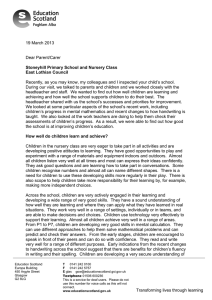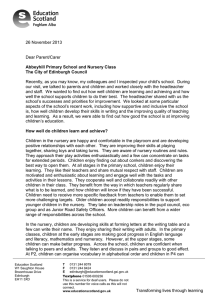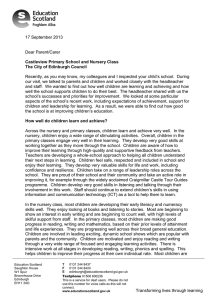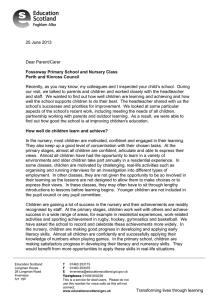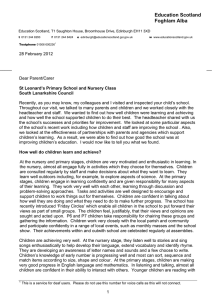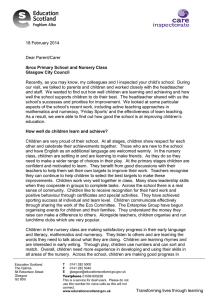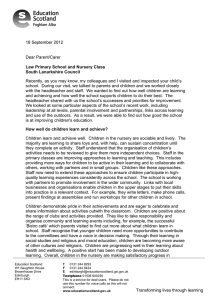26 August 2014 Dear Parent/Carer ’s school. During
advertisement
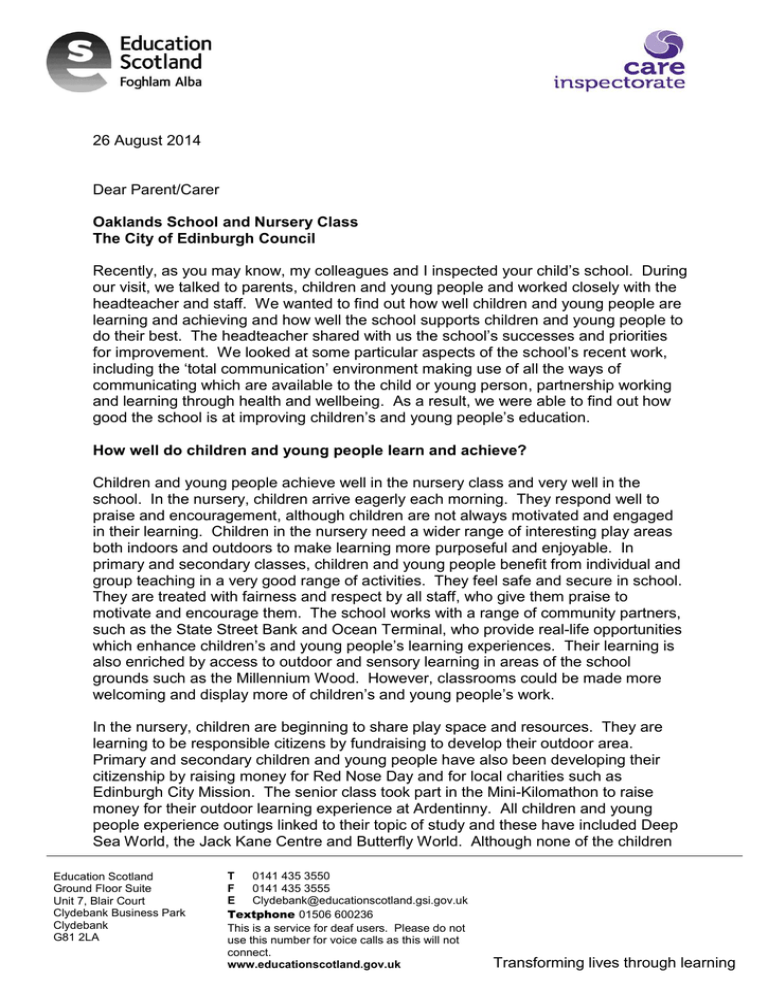
26 August 2014 Dear Parent/Carer Oaklands School and Nursery Class The City of Edinburgh Council Recently, as you may know, my colleagues and I inspected your child’s school. During our visit, we talked to parents, children and young people and worked closely with the headteacher and staff. We wanted to find out how well children and young people are learning and achieving and how well the school supports children and young people to do their best. The headteacher shared with us the school’s successes and priorities for improvement. We looked at some particular aspects of the school’s recent work, including the ‘total communication’ environment making use of all the ways of communicating which are available to the child or young person, partnership working and learning through health and wellbeing. As a result, we were able to find out how good the school is at improving children’s and young people’s education. How well do children and young people learn and achieve? Children and young people achieve well in the nursery class and very well in the school. In the nursery, children arrive eagerly each morning. They respond well to praise and encouragement, although children are not always motivated and engaged in their learning. Children in the nursery need a wider range of interesting play areas both indoors and outdoors to make learning more purposeful and enjoyable. In primary and secondary classes, children and young people benefit from individual and group teaching in a very good range of activities. They feel safe and secure in school. They are treated with fairness and respect by all staff, who give them praise to motivate and encourage them. The school works with a range of community partners, such as the State Street Bank and Ocean Terminal, who provide real-life opportunities which enhance children’s and young people’s learning experiences. Their learning is also enriched by access to outdoor and sensory learning in areas of the school grounds such as the Millennium Wood. However, classrooms could be made more welcoming and display more of children’s and young people’s work. In the nursery, children are beginning to share play space and resources. They are learning to be responsible citizens by fundraising to develop their outdoor area. Primary and secondary children and young people have also been developing their citizenship by raising money for Red Nose Day and for local charities such as Edinburgh City Mission. The senior class took part in the Mini-Kilomathon to raise money for their outdoor learning experience at Ardentinny. All children and young people experience outings linked to their topic of study and these have included Deep Sea World, the Jack Kane Centre and Butterfly World. Although none of the children Education Scotland Ground Floor Suite Unit 7, Blair Court Clydebank Business Park Clydebank G81 2LA T 0141 435 3550 F 0141 435 3555 E Clydebank@educationscotland.gsi.gov.uk Textphone 01506 600236 This is a service for deaf users. Please do not use this number for voice calls as this will not connect. www.educationscotland.gov.uk Transforming lives through learning in the nursery have spoken language, they participate well in an interactive story. They are improving their skills in operating switches and can use these to hear and enjoy the story. A few children can sort objects into categories and class routines help them to understand sequences of events. Most nursery children are becoming increasingly aware of themselves and others. Children and young people in primary and secondary classes are encouraged to communicate in a range of different ways, including pointing, using eye gaze technology and signing, in a total communication environment. They participate well in sensory drama sessions and enjoy being involved in stories. The school should investigate ways to develop sequencing and early literacy skills with learners. Children and young people are developing organisational and money skills during shopping trips. Learners with visual impairments are improving their understanding of space, distance and time through route maps with sighted guides. The school has had success in improving the level of attainment for young people. It has increased the number of subjects available and the number of SQA unit awards achieved by young people from S4 to S6. Staff have introduced new awards such as the Personal Achievement Award and the Junior Awards Scheme Scotland. The school has increased successfully the number of work experience placements available to young people in senior classes. How well does the school support children and young people to develop and learn? The nursery class and school support children and young people very well to develop and learn. In the nursery, learning is focused on communication, mobility and functional skills. Staff also focus on sensory learning, although this could be strengthened. Staff involve partners effectively to develop and enhance children’s learning experiences. Children transferring to the primary stages have opportunities to join the older children for activities and a member of nursery staff moves on with them. Staff now need to develop a clearer nursery curriculum, linked to national guidelines. In the primary and secondary classes, staff aim to enable children and young people to become as independent as possible, to develop their health and wellbeing and to develop communication skills. These aims are clearly linked to learning activities which cover all subject areas. For example, the school is a centre of excellence for MOVE (mobility opportunities via education), an activity-based programme where staff work closely with families and partners to teach children and young people basic movement skills. Learning in the local and wider community is an important part of the curriculum, with regular visits to places of interest, shopping and visits to local facilities. Staff also take the opportunity to expand learners’ experiences and achievements, based on their interests and preferences. However, more work needs to be done by staff to set these activities within a curriculum in line with Curriculum for Excellence. Staff are beginning to make links in learning for learners across subjects. They now need to show how children and young people will develop skills in these subjects and then use them in different areas. Across the school, staff should continue to develop appropriate monitoring and tracking procedures to analyse and improve outcomes for children and young people. In the nursery, resources are well matched to the needs and abilities of children. At times, activities are based on children’s interests and experiences. Children have some opportunities for free play and to choose from a few sensory resources. The nursery has very good links with agencies which support children’s learning. 2 Staff have developed a very effective communication system between home and school. In most primary and secondary classes, learning activities take appropriate account of the differing abilities of children and young people. Most activities provide some challenge for learners, and the pace of learning is appropriate. Most teachers use a variety of techniques to meet the wide range of needs in their class. The well-designed learning environment helps children and young people to gain greater independence in their communication and mobility. The school has very good processes for identifying the needs of children and young people and describes how best to work with each of them in a communication passport. Specialist staff have an important part to play when working with children and young people with such complex needs, including visual impairment, and they work very closely with teachers and other staff to assess and meet these needs. How well does the school improve the quality of its work? The headteacher is dedicated to ensuring the best possible provision for children and young people and works increasingly well with staff and partners to develop this. The school uses a wide range of information to decide on its improvement priorities, including evaluations of school events by parents. Staff have been involved in analysing this information and proposing what should be included in the school improvement plan to improve children’s and young people’s learning. They have been successful in making improvements based on the priorities in the plan, including increasing opportunities for achievement and attainment for children and young people. The school needs to involve parents and partners more in evaluating the work of the school and planning for improvement. Teachers are working well with staff from other schools to agree standards for assessment. They now need to work more closely with each other to share skills, approaches and resources. The headteacher encourages staff to engage in professional learning opportunities to enhance their skills so that they can improve outcomes for children and young people in the school. During the previous Care Inspectorate inspection, the school had no requirements and one recommendation. This recommendation has been met. As a result of this inspection, there are no requirements and six recommendations. This inspection found the following key strengths. Happy, motivated children who enjoy their learning. The highly effective partnership working between teachers, support staff and partner agencies to meet children’s and young people’s needs. The positive impact of the MOVE programme and the total communication environment on children’s and young people’s confidence and independence. Approaches to meeting the complex needs of children and young people with visual impairment. The leadership of the headteacher to ensure the best possible provision for children and young people. 3 We discussed with staff and The City of Edinburgh Council how they might continue to improve the school and nursery class. This is what we agreed with them. Further develop the curriculum in line with national advice. Continue to develop monitoring and tracking procedures to analyse and improve outcomes for children and young people. Review the nursery environment and outdoor area to improve outcomes for children. What happens at the end of the inspection? We are satisfied with the overall quality of provision. We are confident that the school’s self-evaluation processes are leading to improvements. As a result, we will make no further evaluative visits in connection with this inspection. During the inspection, we identified aspects of innovative practice which we would like to explore further. We shall work with the school and The City of Edinburgh Council to record the innovative practice and share it more widely. Ken McAra HM Inspector Additional inspection evidence, such as details of the quality indicator evaluations and national care standards gradings, for your school can be found on the Education Scotland website at http://www.educationscotland.gov.uk/inspectionandreview/reports/school/primsec/Oakl andsSpecialSchoolEdinburghCity.asp If you would like to receive this letter in a different format, for example, in a translation please contact the administration team on the above telephone number. If you want to give us feedback or make a complaint about our work, please contact us by telephone on 0141 282 5000, or e-mail: complaints@educationscotland.gsi.gov.uk or write to us addressing your letter to the Complaints Manager, Denholm House, Almondvale Business Park, Livingston EH54 6GA. 4
